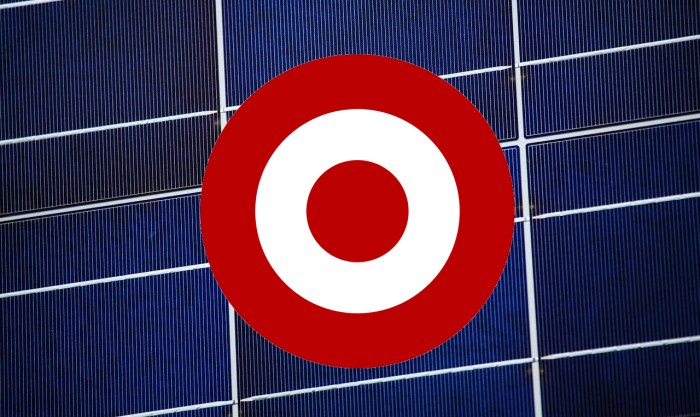
Not the Australian Target, the other one
2017 was the third biggest year for on-site solar installations among the USA’s largest companies. The leading business last year was Target for the second year in a row, with 40MW of new capacity installed.
While not covering all commercial solar activity in the U.S., the SEIA’s latest Solar Means Business report focuses on on-site solar installations by the country’s biggest businesses.
The top ten for installed capacity in the USA at the end of 2017 (cumulative totals):
- Target / 205.03 MW
- Walmart / 149.43 MW
- Prologis / 120.72 MW
- Apple / 79.40 MW
- Kohl’s / 51.49 MW
- Costco / 50.75 MW
- General Growth Properties / 50.21 MW
- IKEA / 44.85 MW
- Macy’s / 35.28 MW
- Amazon / 33.60 MW
The top 25 corporate solar users added 325MW of solar capacity last year, an increase of 43% over the installations just two years prior (but only 2% up on 2016).
“To leading companies across America, deploying solar is a common-sense business decision,” said Abigail Ross Hopper, president and CEO of SEIA.
The full Solar Means Business 2017 Report can be accessed here.
One Target Is Not Like The Other
While Target may have led in the USA, its Australian doppelgänger’s solar street cred isn’t so hot. Target Australia doesn’t appear to have installed any solar recently, but its 2017 Sustainability Report mentions “development of design, installation and management standards for solar panels”; so it seems PV is on the drawing board.
Even though it may share the same logo and have other similarities, Target in Australia is not under the same ownership as in the USA and Target Corp. has no affiliation with Target Australia.
IKEA has been whacking up quite a few panels on its facilities in Australia. Back in 2014, IKEA announced a 3.9MW rooftop solar PV project to be carried out by Canadian Solar, consisting of 7 commercial rooftop PV systems in three states. It’s not clear what IKEA’s current Australian solar capacity is.
According to IKEA’s 2017 Sustainability Report, globally it produced over 3.2TWh of renewable energy (wind/solar photovoltaic/biomass) in its 2016 financial year, equivalent to 71% of the energy consumed by its operations. It says that by 2020, it will generate as much energy from renewables as company operations consume.
Apple, as we mentioned recently, says all its global facilities including retail stores, offices, data centres and co-located facilities in dozens of countries (including Australia) – are now powered via 100 percent renewables. Last year, it brought 286 megawatts of solar PV online globally.
Commercial Solar Even Better In Australia
While commercial solar is proving to be a cost-effective way for U.S. businesses to rein in their electricity costs, it’s even more the case in Australia given our higher electricity prices. In fact, if an Australian business can afford to pay its power bills, these days it’s a situation of also being able to afford to go solar.
A business doesn’t have to be a multi-national, Fortune 500 concern to reap the benefits. Commercial solar for Australian small businesses can now pay back in under 3 years.

 RSS - Posts
RSS - Posts



Speak Your Mind